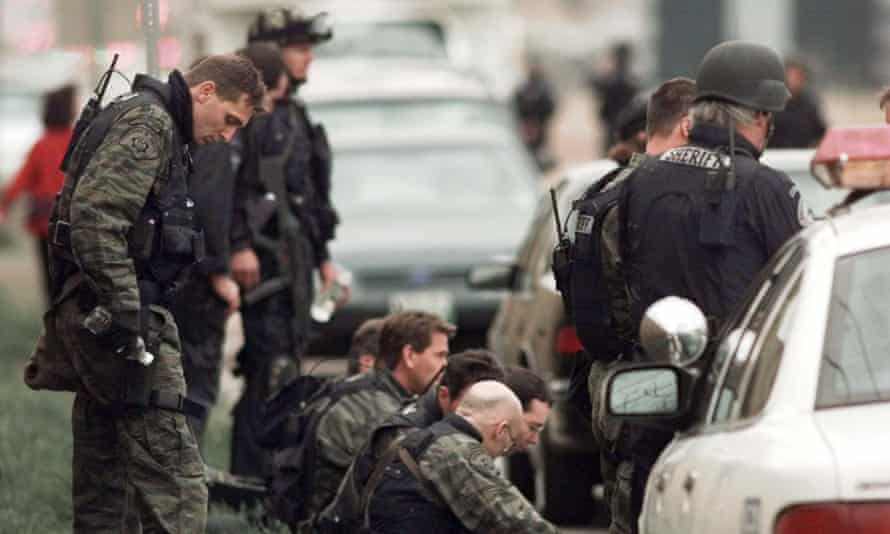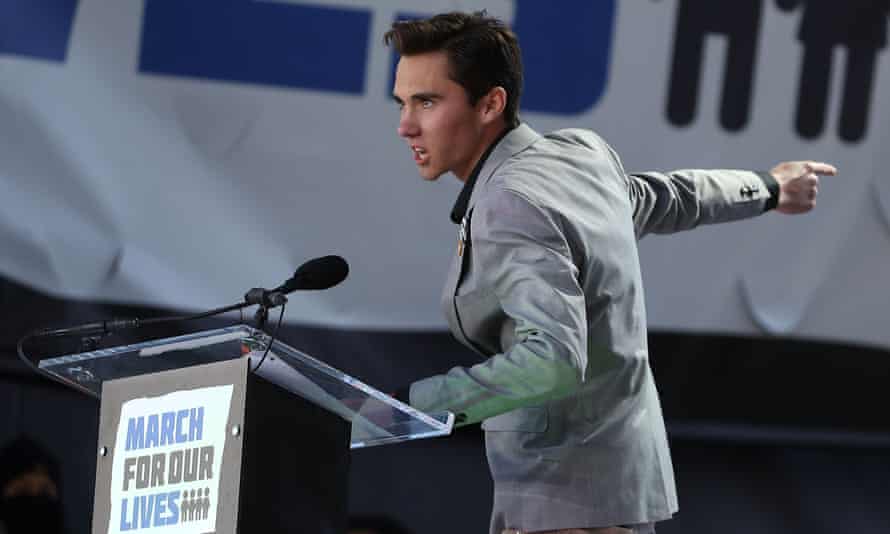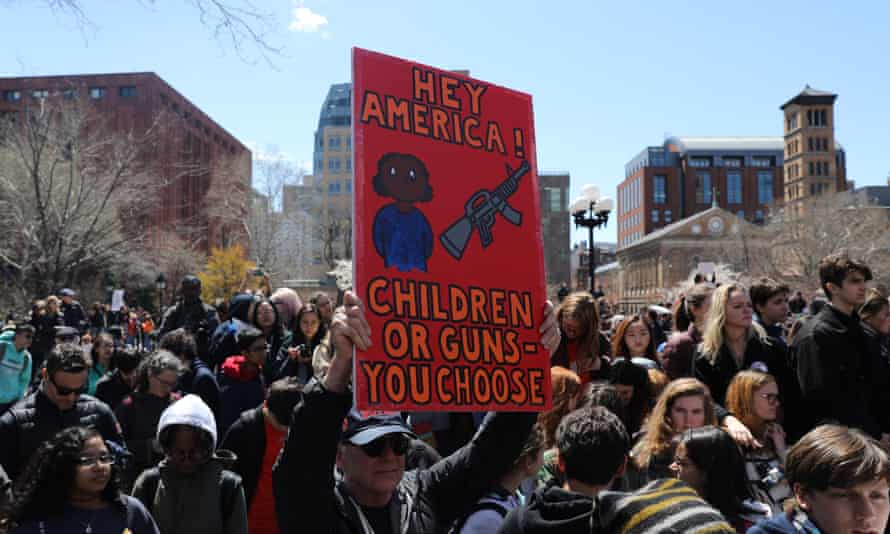Comparative Review on Parkland to Columbine School Shootings
A s I drove down Highway six toward the Rocky Mountains on 20 April 1999, hoping to find this loftier school I had never heard of in Columbine, where shots had been reported but no injuries, I had no conception of what I was almost to witness. What was happening within that high school was unimaginable. What it ignited was far worse.
Who could accept known what we were in for? The police weren't set up: they surrounded the school and waited for demands that never came. There was no active shooter protocol; the "lockdown drill" was however unconceived and inconceivable. Why would nosotros drill kids to hide from gunmen? None of u.s. had an clue that the school shooter era had begun.
The school shooter era. Even 10 years after Columbine, I still couldn't perceive what we were living through in that mode. No one could. It had been going on far too long, merely it was difficult to predict its endurance or trajectory. While I despise the media scorekeeping – application the killers titles like prizefighters, giving them exactly what they crave – one stat is worth noting: what was then the most notorious mass murder in recent American history no longer ranks in the peak 10. Four of the five deadliest attacks in the US accept occurred since so, three of them in the past three years. In a five-24-hour interval menstruation nigh the finish of concluding month, the US suffered four mass murders in four unlike states: Louisiana, Georgia, Pennsylvania and Florida. This is not going away, it'southward getting worse.
20 years later, I am still on this story not just because of what happened, but also considering of how the media responded. Nosotros got information technology wrong. Absurdly wrong. Nosotros were shocked and horrified and drastic for answers, serving a public hungry for a reason for the "madness," so nosotros found an respond. Information technology was wrong.
Since 20 April 1999, I have studied nigh of the major mass shootings and some of the smaller ones. I have written near them individually and collectively. I have joined the Academy of Critical Incident Assay (ACIA) squad in studying several incidents, including on-site studies at Virginia Tech after the 2007 shooting and in Las Vegas in 2017, and an off-site analysis of Norway's 2011 Workers' Youth League attack in Utøya. A troubling tendency emerged: many of the mass murderers emulated Columbine killers Eric Harris and Dylan Klebold. The FBI released more than 1,500 pages of documents near the horror at Sandy Hook elementary schoolhouse in Newtown, Connecticut in 2012, when Adam Lanza killed xx offset-grade students and six members of staff, as well every bit his own female parent. It details just how obsessively Lanza was following Harris and Klebold. He amassed a hoard of Columbine data on his hard drive, frequented a conversation room dedicated to the attack, and function-played the killers in an online game. If merely this were an isolated incident.
I experienced two breakdowns of secondary traumatic stress seven years autonomously writing Columbine, then I studied the subsequent tragedies at a safety emotional distance and swore I would never plunge back into the scene of a law-breaking. Terminal twelvemonth, when a shooting erupted at Marjory Stoneman Douglas high school in Parkland, Florida, I bankrupt that promise, because Parkland seemed different. The Parkland students immediately led an uprising against lax gun laws. Emma González striking dorsum. David Hogg called out developed America for letting children die. The nation was galvanised, and five weeks after, their band of high school students led one of the largest protests in American history.
Whatsoever reasonable observer outside the US would have concluded long before the Parkland shooting that something had to be washed. In fact, as the death count rose, media and public attending had waned. The nonprofit news system The Trace has studied media coverage of these tragedies, and measured a meaning decrease in coverage by 2018. About two decades into this epidemic, the US had settled into a state of defeatism.
We had good reason. In the wake of Columbine, America was united in i idea – that something had to change in 3 obvious areas: law, schools and guns. The police surrounding Columbine Loftier had failed to consider the possibility that the gunmen had no demands. They just wanted to kill people. After considerable assay, police force forces across America upended their response to these attacks with the active shooter protocol. They now neutralise almost major attacks within minutes, saving countless lives. Schools responded likewise, with threat assessment teams, lockdown drills and accelerate coordination with constabulary enforcement, who now have blueprints to their buildings and alert codes. The changes were swift, and dramatic, but they were primarily aimed at reducing the death count in one case bullets were already in the air.
On prevention? On minimising the ability of perpetrators to arm themselves to the hilt, U.s.a. politicians responded with ... zero. Worse than nothing, they have regressed. Columbine brought great hope for gun control, but almost no meaningful legislation. Politicians of all stripes were afraid of the power of the National Rifle Association (NRA). In 2000, vice-president Al Gore stuck his neck out. He defied the conventional wisdom that gun control was politically toxic, ran on it and lost the electoral higher, by a whisker, in two southern states he should have carried easily. Either i would take led to him defeating George W Bush. Guns were blamed, and the Democrats went from squeamish on gun command to terrified.
In the media, meanwhile, we carry at least some of the blame for this spiralling problem. What I failed to grasp that day I arrived in Columbine was how we were botching the story – and the staggering ramifications of mislaid good intentions. I had no idea that I might be playing a role, and bear some responsibleness for the children still dying effectually usa ii decades after.
My first clue came that evening, on my drive home to Denver. I had filed a written report by phone to Salon.com in San Francisco. I flipped on the radio for some respite and in that location was no music. Information technology was all Columbine all the time on every station, and the story I was hearing sounded alarmingly unlike from the one I idea I'd just witnessed. The "what" was exactly what I'd reported – "upwards to 25 expressionless", though that would be proved as wrong – but the "why" all over the radio was unnerving. I'd spent nine hours with students, cops and distraught parents in Clement Park, the huge grassy expanse surrounding the school, and still had no inkling at all why those boys had done this, other than insanity – which would also be proved wrong. Every other reporter in the field had apparently uncovered their motives: the killers had targeted 2 groups, jocks and black people, and were patently racists striking dorsum against ruthless bullying. I was distraught. How had I missed all that? Information technology was the biggest story I'd ever been a part of, and I'd blown it.

The adjacent morning time, I did something worse. I changed my story. I'd gone domicile and turned on the Goggle box to run into the radio story validated everywhere. I'd awoken to the morning time papers and the TV news correcting the death count from 25 to 15, but trumpeting the primary narrative, still with us today, of two bullied, loner outcasts from the Trench Coat Mafia exacting revenge. It'south a powerful story, just entirely fictional. Every element of that narrative would turn out to be simulated. But that morn, the driving emotion for me was humility. Patently, I was the one in the wrong.
It had all happened and so rapidly. Years after, I expected to trace the origin of the myth over the offset week or 2, analysing all the major newspapers' coverage. But the genesis had to be measured in hours, not days, and the CNN transcript from 20 April told nearly of the story. It's a remarkable certificate, because the networks cut between iv local stations' feeds, providing a cross-department of virtually all the live on‑site Boob tube coverage. Most of the major myths all the same haunting united states solidified in those first few hours. Over the course of that afternoon, reporters went from request if the killers targeted jocks and black people, to asking kids to confirm reports of the targeting, to beginning to state it every bit a fact. At that place was a similar progression with the killers being bullied, loners, outcasts and goths.
The assault began outside, where every witness reported Harris firing indiscriminately. And two days later, two huge propane bombs were discovered in the cafeteria. Information technology was clear that the killers had intended to blow up a fly of the schoolhouse, killing close to 600 students instantly. Could that really be chosen targeted?
The 23 Apr edition of the New York Times is chilling. The front folio led with two Columbine stories, side by side. The story on the left explored the motives, unequivocally stating: "The killers, who targeting athletes …" The story on the right revealed the bomb discovery – disproving the targeting theory reported as fact abreast it. Worse, the stories ran under a single imprint announcing that the killers intended to "Destroy the schoolhouse". No one called them out on the absurdity – because well-nigh all of us were locked in the same cerebral dissonance, reporting information technology the same absurd way.
The jock theory hinged entirely on four words one of the killers shouted in the library: "All jocks stand up." But they had shouted all sorts of slurs virtually every believable group during the slaughter. Why did nosotros turn the jock phrase into the primary motive, and the explanation for the entire attack?
Because it made a bully story. Non but to journalists, to the survivors too. The nation was desperate for an explanation, and bullying jocks made plausible targets. Information technology didn't just fit, it explained everything. Then piece of cake to imagine these outcast boys, ruthlessly tormented until they reached breaking point and struck back. Then what if none of the evidence fitted?

The problem didn't start with Columbine. Journalists began the afternoon with leading questions, and Columbine students acquiesced and then easily, because smaller-scale school shootings had already been afflicting us, and there was a widespread "understanding" of the shooter contour: bullied loner outcasts. Both the FBI and clandestine service would after deflate those profiles, but there was little reliable data at the fourth dimension. Past misconceptions were speedily projected on to the Columbine killers: imaginary heroes of the downtrodden concocted largely over the grade of one afternoon.
In fact, the two were uninterested in their particular victims, just the body count. Mark Juergensmeyer, one of the cracking thinkers on terrorism, captured the essence of that phenomenon in one phrase: performance violence. A defining feature of terrorism is some sort of political agenda. But the Columbine killers realised they could use those same tactics for their own piffling self-aggrandisement. A whole generation of murderers accept followed in their wake.
It took several months, but eventually all the major media ended that we had the motive story hopelessly incorrect. Within a year, most big impress outlets had published some sort of correction. The trouble was that hundreds of millions of people had gobbled up the early on coverage – CNN logged its highest ratings in its history to that point, the New York Times page ane featured Columbine for nine consecutive days – and hardly anyone noticed the corrections. They certainly didn't dislodge readers' entire formulation of a seminal moment in modern American history. Myths are for ever.
I spent a decade after Columbine battling those myths, sorting the truth and somewhen publishing a book, Columbine, around the 10th anniversary. Reporters withal enquire me what they should learn from the Columbine debacle, and I say get it right the first time, considering we tin never untell the myths we spin.
Information technology was just in the second decade of the school shooter era that we discovered only how pernicious those Columbine myths would prove. An exhaustive secret service written report found that most of the school shooters during that catamenia were distraught and deeply depressed, with suicidal thoughts or intentions. About felt a sense of loss or failure, and seemed to be crying out in desperation for a sense of power and a voice. They were rarely targeting the individuals they killed; the victims were collateral damage in the service of an impressive body count. I have taken to calling them spectacle murders, because they are substantially performances – and without the media, they have no stage. No voice. We play correct into their hands.

The No Notoriety movement began to gain a foothold virtually a decade after Columbine, only didn't really gain momentum until 2015. The manifesto at nonotoriety.com is quite modest and sensible, calling on journalists not to stop naming or showing killers entirely, only to "minimise damage". It asks them to "limit the proper name to once per slice every bit a reference betoken" and downplay photos, for example, putting them beneath the fold in newspapers. Nonetheless even though Anderson Cooper began refusing to name mass killers on his highly rated CNN show AC360, demonstrating how piece of cake it was, very few shows followed. In 2015, People magazine became the start major publication to adopt a No Notoriety policy. In November 2018, BuzzFeed appear a new harm-reduction policy directing reporters and editors to terminate the gratuitous use of the names or images of mass shooters.
For many outlets, the trouble remained that the killers tended to be more interesting than their victims – not but to journalists, but to readers and viewers. As the recent controversy around the forthcoming Ted Bundy motion picture illustrates, humans volition always be fascinated by criminal minds. It'due south why cop shows boss Television set and law-breaking fiction sells. Nosotros in the media tin can diminish the killers' profiles, but as long as the audience craves stories almost them, they will become famous.
In the case of schoolhouse shootings, that conundrum seemed unsolvable – until the Parkland kids flipped the script. David Hogg became the showtime mass shooting victim to become more famous than his attacker. Information technology took him less than 24 hours. Ii days later, Emma González went viral with her "Nosotros call BS" speech and was a household proper noun across the Usa and much of Europe. In her commencement week on Twitter, she surpassed a million followers. Their assailant is a nobody.
When writing my book virtually Parkland, I chose to erase the killer'southward proper noun. It was an easy choice. He is insignificant. Nosotros demand to report these killers equally a grade, but the FBI has done that. Information technology wasn't a tough conclusion, though. The Parkland kids fabricated it easy. I didn't go to Parkland to embrace the gunman, I went because I was fascinated by the students. America was fascinated. The earth was fascinated. In Nov, Archbishop Desmond Tutu bestowed on them the International Children's Peace prize, calling their campaign "reminiscent of other bang-up peace movements in history".
The Parkland students decided in the get-go few days that they needed to speak with one vocalisation, and focus on gun prophylactic. March for Our Lives followed on 24 March 2018. Estimates state that betwixt i.four and ii.1 million people marched in the Usa that twenty-four hours, making information technology the 3rd or fourth largest 1-solar day protestation in American history, equivalent to the largest protest of the Vietnam state of war era, led by college students, who had been rallying for the better part of a decade. The Parkland uprising was organised past high school students in five weeks.
When Parkland was attacked last Valentine's Day, supporting gun safety was considered politically toxic. Suddenly, for the first time in a generation, it is starting to abound politically toxic to oppose it. The NRA is non rolling over and the battle volition rage for years, but the Parkland kids have achieved stunning success in the first year. Country legislatures reversed the NRA momentum, passing 67 laws tightening access to guns. But the large prize was the November midterms. Democrats finally stopped cowering on gun laws, ran on reforming then, and retook the Firm of Representatives. Even Republicans in some key swing districts ran on gun rubber. They didn't all win, but the movement exceeded the wildest expectations last February of what they might accomplish.
The Parkland kids have also helped to solve some other problem: robbing spectacle murderers of the spotlight they crave. I was pleased to discover that, while doing media interviews for my volume, hardly whatsoever journalists could recall the Parkland shooter's proper noun – even those who had covered the story. Nevertheless millions of American schoolchildren tin proper noun a dozen of the March for Our Lives kids, and follow them daily on social media.
These survivors accept truly eclipsed their killer. The solution was very simple: they did something more than powerful.
Source: https://www.theguardian.com/books/2019/feb/10/columbine-parkland-gun-crime-dave-cullen
0 Response to "Comparative Review on Parkland to Columbine School Shootings"
Post a Comment